- 종교적 성향과 실재에 대한 인식 - Gallup International 다국가 조사 #75주년 #신 #사후세계 #천국 #지옥 #무신론자
- 조사일 : 2022/10/31
- [GallupReport(20230404)_ReligiousTendency.pdf] 다운로드
● 2023년 4월 4일(화) 공개 | 문의: 02-3702-2571/2621/2622
종교적 성향과 실재에 대한 인식 - Gallup International 75주년 다국가 조사
→ 한국+세계 조사 결과 파일 다운로드(PDF)
/ 세계 조사 개요
- 2022년 8~10월 61개국 성인 총 57,768명 전화/온라인/면접조사(주제별 참여국 상이)
/ 한국 조사 개요
- 조사기간: 2022년 8월 23~31일
- 표본추출: 사회연구패널★에서 성·연령·지역별 층화 추출
(한국갤럽이 무선전화 RDD 방식으로 구축·운영하는 확률 기반 조사패널)
- 응답방식: 모바일조사(조사대상자에게 문자메시지 발송, 자기기입식 웹조사)
- 조사대상: 전국 만 19~79세 1,035명
- 표본오차: ±3.0%포인트(95% 신뢰수준)
- 문자 발송 대비 응답 완료율: 46%(총 2,263명 중 1,035명)
- 의뢰처: 한국갤럽-Gallup International 자체 조사
/ 문항
→ 종교적 성향: 나는... 종교적/비종교적/무신론자
→ 종교적 실재에 대한 믿음 여부: 신, 사후 세계, 천국, 지옥
조사 결과
2022년 8~10월 61개국 시민 62% '나는 종교적인 사람',
'종교적이지 않은 사람' 24%, '무신론자' 10%
- 사하라 이남 아프리카, 남아시아, 비EU 유럽 대체로 종교적
- EU와 동아시아 국가는 상대적으로 덜 종교적, 다섯 중 한 명은 무신론자
갤럽 인터내셔널이 2022년 8~10월 61개국 시민 57,768명에게 종교 활동 참여 여부와는 별개로 자신이 종교적인지 그렇지 않은지, 또는 무신론자인지 물었다. 그 결과 61개국 시민 62%가 자신을 '종교적인 사람'으로 자처했고, 24%는 '종교적이지 않은 사람', 10%는 '무신론자'라고 답했다. 4%는 의견을 유보했다.
◎ 이러한 종교적 성향은 단기간에 크게 바뀌지 않는 것으로 보인다. 갤럽 인터내셔널의 2016년 같은 질문에 당시 조사 참여국 시민 62%가 스스로 종교적인 사람이라고 답했고(비종교적 25%, 무신론자 9%), 2014년 조사에서도 거의 유사한 양상이었다.
◎ 종교적인 사람이 가장 많은 나라는 세네갈·케냐(97%), 파키스탄(95%), 코소보·에티오피아(94%), 조지아(91%) 순이며, 룩셈부르크(28%), 프랑스·타이(27%), 홍콩(26%), 베트남(25%), 스웨덴(23%), 체코(21%), 일본(15%) 등에서는 그 비율이 30%를 밑돌았다. 61개국을 권역별로 나눠 보면 사하라 이남 아프리카(89%), 남아시아(88%), 비EU 유럽(80%)에서 대체로 종교적 성향이 강하고, EU(43%)와 동아시아(40%)는 상대적으로 덜 종교적이며 무신론자(18%)도 적지 않다.
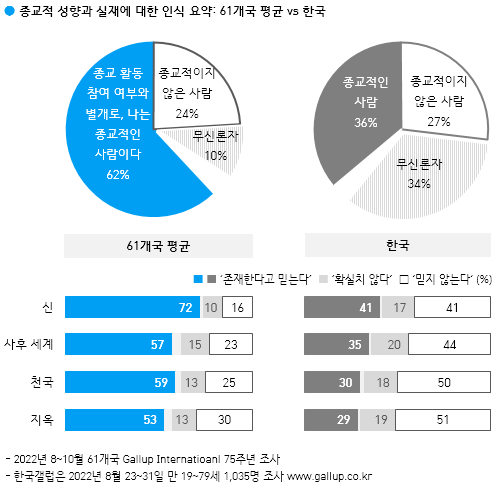
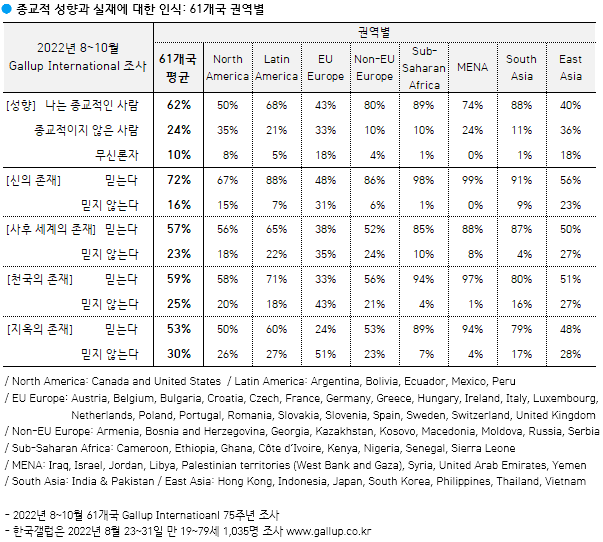
──
61개국 시민 72% '신이 존재한다고 믿는다'
- 열 명 중 대여섯은 사후 세계·천국·지옥 존재 믿어
다음으로, 현재 자신의 종교와 무관하게 신·사후 세계·천국·지옥 각각의 존재를 믿는지 물었다. 그 결과 61개국 시민 중 72%가 '신의 존재'를 믿었고, 16%는 믿지 않았다. 천국의 존재를 믿는 사람은 59%(:'믿지 않는다' 25%), 지옥은 그보다 약간 적은 53%(:30%), 사후 세계는 57%가 존재한다고 봤다(:23%). 즉, 선행 질문에서 자신이 종교적이라고 밝힌 사람(62%)보다 신의 존재를 믿는 사람(72%)이 더 많고, 사후 세계나 천국과 지옥의 존재를 믿는 사람은 그보다 적은 편이다.
◎ 권역별로 보면 MENA(중동·북아프리카), 사하라 이남 아프리카, 비EU 유럽, 중남미 등에서는 시민 대다수가 신, 사후 세계, 천국과 지옥이 존재한다고 믿지만, 동아시아에서는 절반가량만 그러하며, 가장 회의적인 곳은 EU였다.
──
한국은 종교적 36%:비종교적 27%:무신론자 34%
- 60·70대 남녀 종교적 성향과 실재에 대한 믿음 대척
한국 조사는 2022년 8월 23~31일 전국 만 19~79세 1,035명을 대상으로 했다. 한국인 중에서는 36%가 자신을 '종교적인 사람', 27%는 '종교적이지 않은 사람', 34%는 '무신론자'라고 밝혔다. 자신이 종교적이라고 생각하는 사람은 남성(29%)보다 여성(43%), 고연령일수록(20대 17%; 60·70대 55%) 많으며, 특히 60·70대에서 성별 차이가 두드러졌다(남성 36%, 여성 72%).
◎ 한국인의 종교적 실재에 대한 믿음은 '신' 41%, '사후 세계' 35%, '천국' 30%, '지옥' 29%로, 61개국 평균을 크게 밑돌았다. 종교적 성향과 마찬가지로 남성보다 여성, 고연령일수록 이들의 존재를 더 많이 믿고, 성·연령별로 보면 60·70대 남성과 60·70대 여성이 가장 대척점에 자리한다.
──
종교적 성향
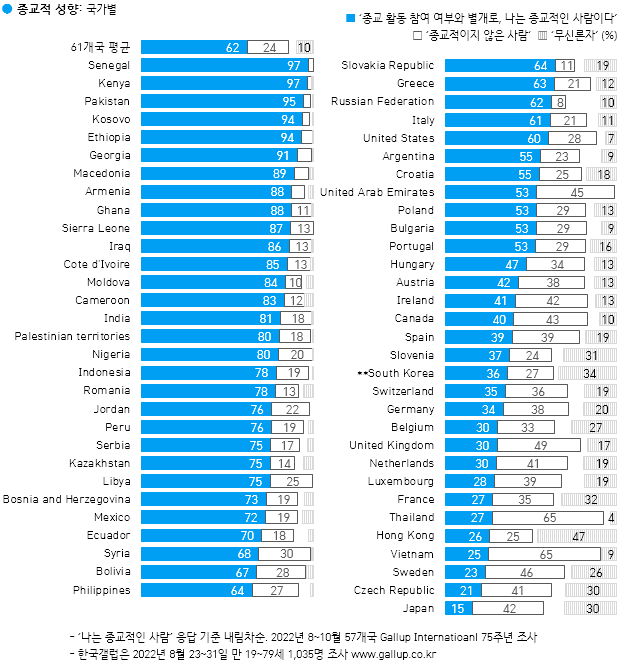
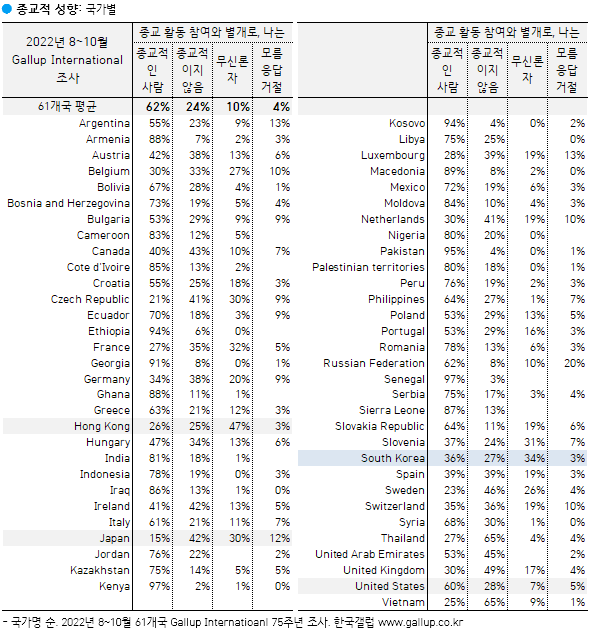
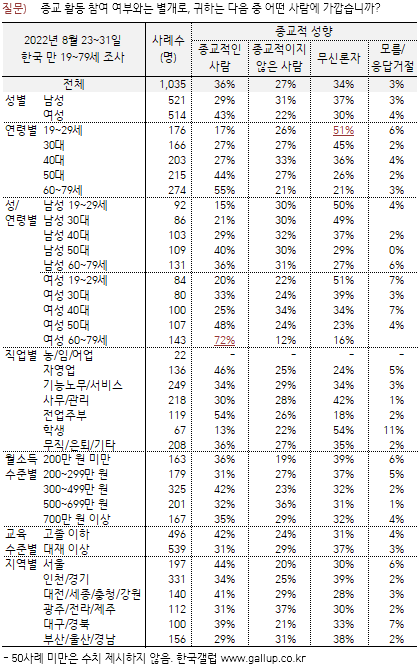
──
신의 존재
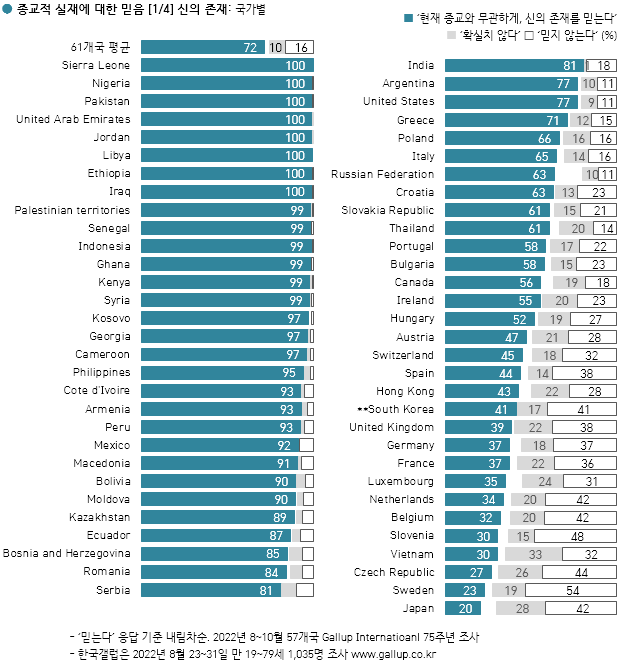
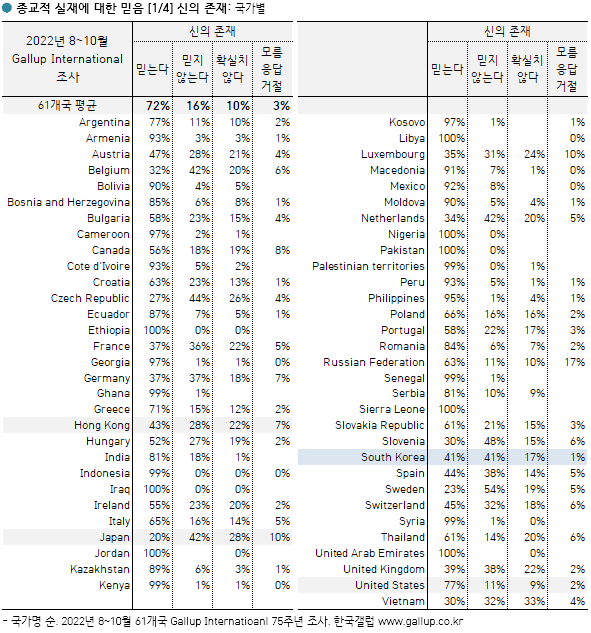
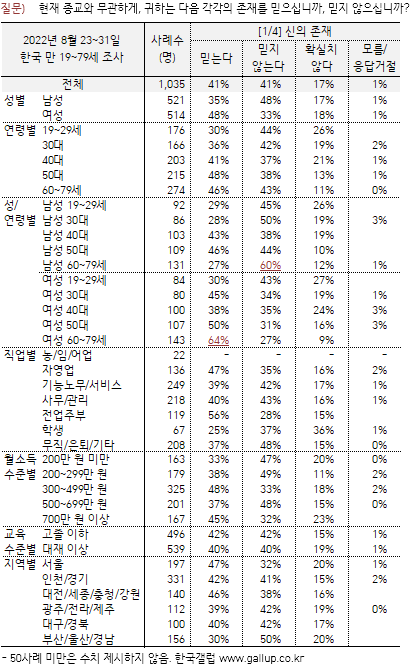
──
사후 세계의 존재
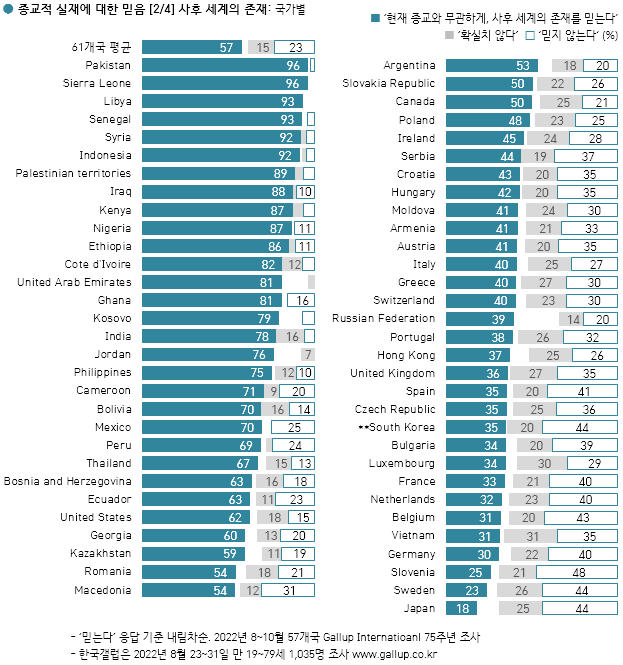
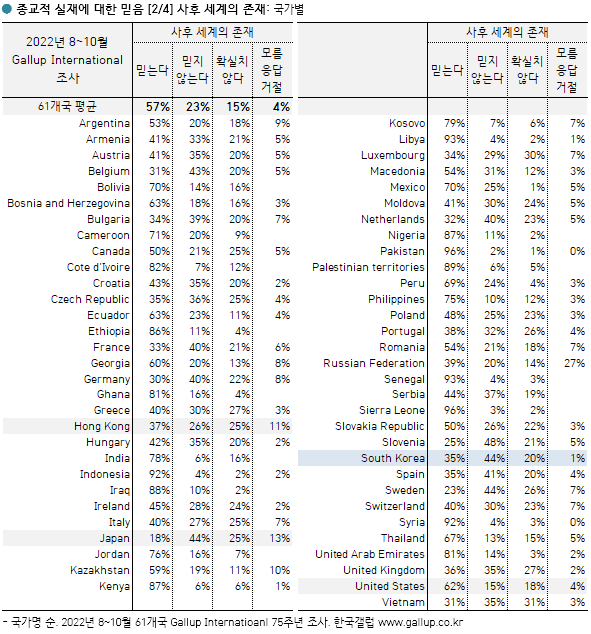
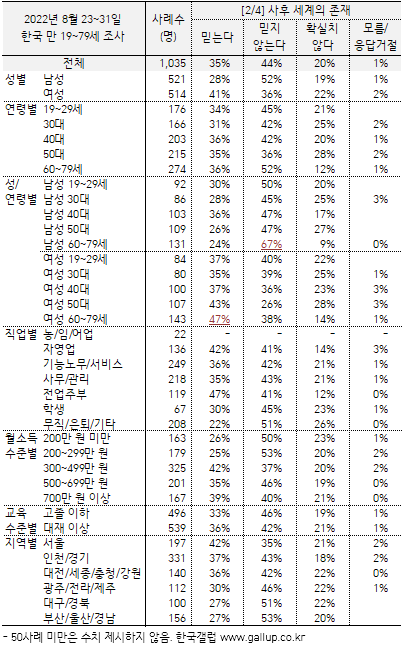
──
천국의 존재
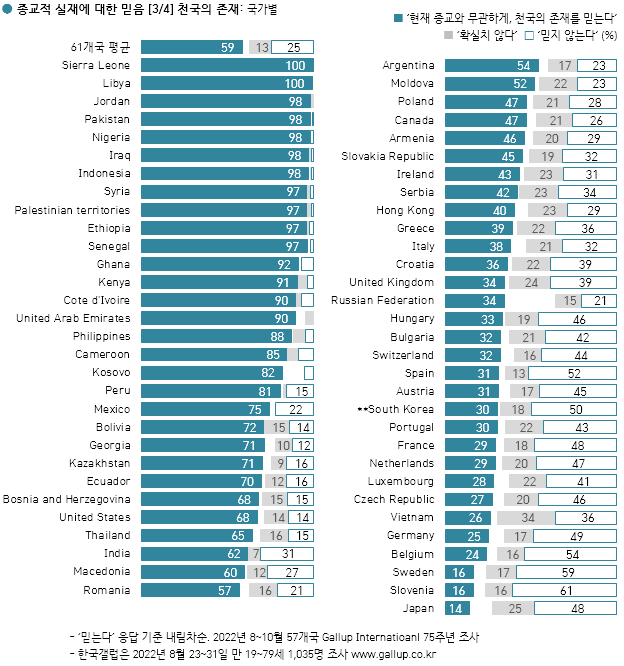
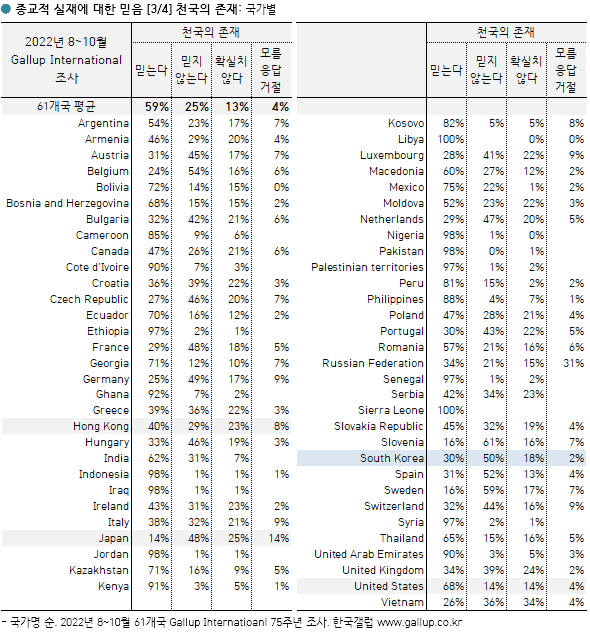
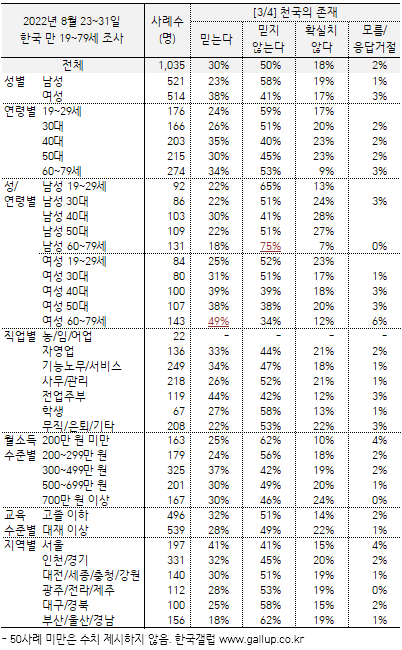
──
지옥의 존재
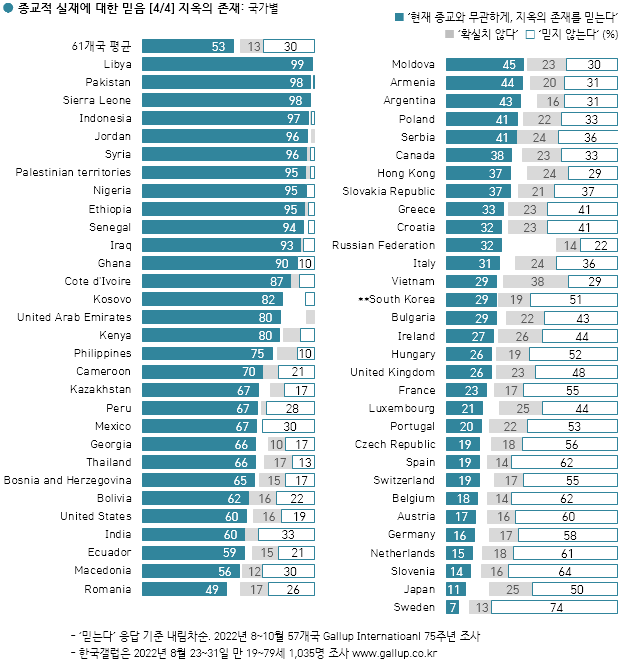
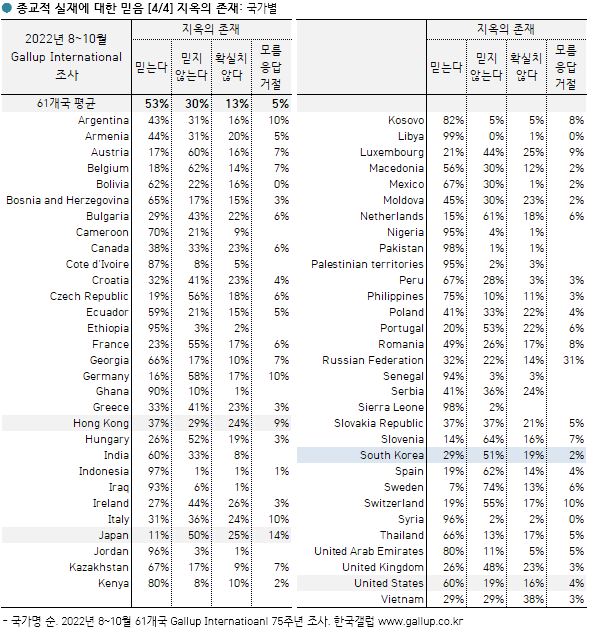
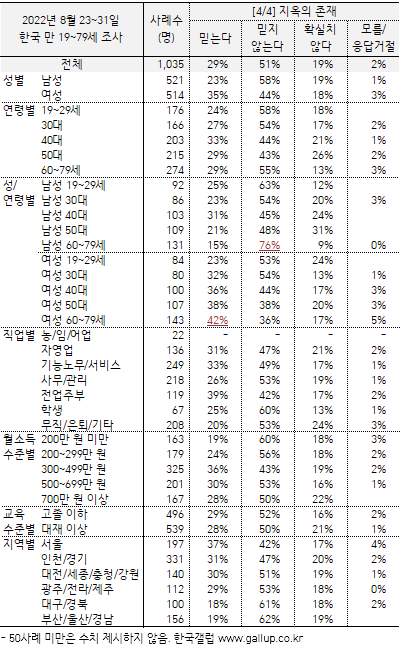
──────────────────
More Prone to Believe in God than Identify as Religious.
More Likely to Believe in Heaven than in Hell.
──────────────────
Two thirds of respondents around the world claim they are religious. Slightly more people believe in God and there is a life after death – according to a majority around the world. A majority also agree that there is a heaven and hell (although we are more confident in the “Good place” than the “Bad one”). Whether religious or not most people seem to believe that there is some mighty power beyond our understanding – a God.
Religious beliefs are more influenced by education, age and personal income.
These are some of the highlights from the special poll conducted by Gallup International Association (GIA) in 61 countries covering over two thirds of the global population (and more than 90% of those countries which are free to conduct and publish opinion research). The poll celebrates GIA’s 75th anniversary.
Religious affiliation around the world.
Two thirds (62%) of respondents around the world say they are religious, with one in four saying that they are not religious. Atheists account for 10%. The rest are not sure.
A few years ago (2016), GIA asked the same question. Overall attitudes towards religion seem relatively stable, as in 2016 again two thirds (62%) said they were religious and 25% that they were not. Atheists were 9%. It’s a similar pattern in the same questions also asked in 2014.
Our current wave of polling further confirms that age, income, and education seem to be important defining demographics for one’s religiosity. The higher the income and education, the lower the likelihood is that someone will self-define as a religious person. The lower the age – the higher is the declared religiosity.
People in EU and East Asia are the least religious with shares of around 40% confirming religiosity. People of Sub-Saharan Africa, South Asia and non-EU European countries on the other hand express much stronger religious affiliation (as much as 90% in some countries).
These attitudes in different regions remain stable. In 2014 and 2016, Africa and the Middle East stood out as most religious regions, according to people’s personal declarations. Western Europe, Asia, Oceania were regions where people defined themselves much less as religious. Asia was once again the region with the largest number of atheists. Some major countries such as USA and Russia show a slight shift in their citizens’ religious attitudes over recent years. For instance, 56% (US) and 70% (Russia) of people in 2014 said they were religious. Two years later the US remains the same while Russia drops to 61%. Today the share of those who define themselves as religious is almost equal – 60% in the States and 62% in Russia.
Our most religious countries in the survey now are Kenya, Senegal, Pakistan, Ethiopia and Kosovo. Least religious are people in Japan, Czech Republic, Sweden and Vietnam.
God and Afterlife
More people believe that there is a God. While 62% self-identify as religious, 72% say that there is a God. Just under one in seven (16%) however do not believe that any God exists. 10% are not sure.
Those attitudes appear largely stable over recent years, although the belief in God has even has slightly increased from 71% in 2016. Again, Sub-Saharan Africa, South Asia and European countries outside EU show significantly larger shares of people confirming the existence of God. Most doubtful are people in EU and East Asia+Oceania. North America sees more of a division in opinion, while Latin America and MENA score on the rather higher end of affirmation of God’s existence.
Most respondents around the world (57%) think that there is a life after death. One in four (23%) do not believe that anything happens when we die. 15% cannot say.
Regions such as MENA, South Asia and Sub-Saharan Africa are among places where people are most prone to believe in the afterlife. The European Union again stands out as the place where people are the least convinced that anything happens after we die. Non-EU European countries, East Asia and North America are somewhere in-between.
People in such countries as Pakistan, Sierra Leone, Libya, Senegal and Indonesia are more likely to believe in life after death. Japan, Vietnam and most EU countries seem most sceptic.
Heaven and Hell
59% believe in heaven, with one in four denying its existence. Fewer people (yet still a majority, 53%) believe in hell.
Religious beliefs are much more constant and sustainable and thus less prone to short term change. Yet on all indicators it seems that there is a slight, almost unnoticeable, shift around the world towards more religion. Maybe in times of crisis people are more prone to turn to religion and transcendental explanations?
Kancho Stoychev,
President of Gallup International Association:
“Religion is such a complex social relation that defining religiosity only through formal criteria like frequency of visiting religious services, following given restrictions or behavioral practices might be misleading. On the other side measuring religiosity only through self-assessment carries a dose of uncertainty. But if we accept the concept that religiosity is first (and maybe only) а deep personal matter then “How I feel” is the important indicator.”
──
한국 응답자 특성표
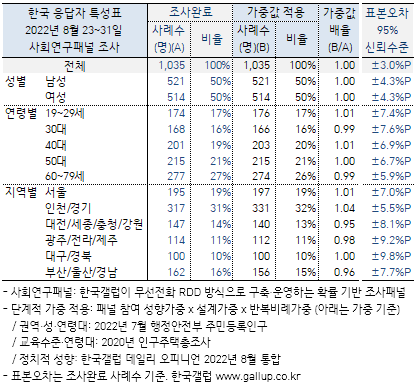
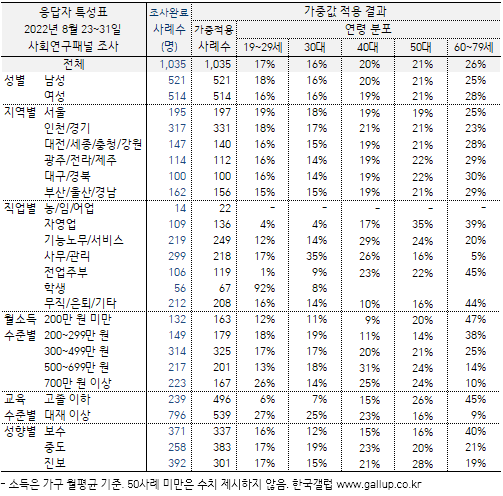
| 1947년 조지 갤럽 박사가 설립한 갤럽 인터내셔널(Gallup International Association)은 매년 전 세계 회원사 공동으로 주요 현안에 관한 여론을 조사합니다. 2022년 가을에는 설립 75주년을 기념하는 조사를 했고, 올해 상반기 몇 차례에 걸쳐 그 결과를 전하고 있습니다. 〈경제·안보 전략적 파트너〉 〈현세대 삶 평가, 다음 세대 삶 전망〉 〈국외 이주 의향〉 〈향후 25년간 전망 10가지〉에 이어, 오늘은 종교적 성향과 실재에 대한 인식을 알려드립니다. → Press release for the 120th Anniversary of Dr. George Gallup |
종교적 성향과 실재에 대한 인식 - Gallup International 75주년 다국가 조사
→ 한국+세계 조사 결과 파일 다운로드(PDF)
/ 세계 조사 개요
- 2022년 8~10월 61개국 성인 총 57,768명 전화/온라인/면접조사(주제별 참여국 상이)
/ 한국 조사 개요
- 조사기간: 2022년 8월 23~31일
- 표본추출: 사회연구패널★에서 성·연령·지역별 층화 추출
(한국갤럽이 무선전화 RDD 방식으로 구축·운영하는 확률 기반 조사패널)
- 응답방식: 모바일조사(조사대상자에게 문자메시지 발송, 자기기입식 웹조사)
- 조사대상: 전국 만 19~79세 1,035명
- 표본오차: ±3.0%포인트(95% 신뢰수준)
- 문자 발송 대비 응답 완료율: 46%(총 2,263명 중 1,035명)
- 의뢰처: 한국갤럽-Gallup International 자체 조사
/ 문항
→ 종교적 성향: 나는... 종교적/비종교적/무신론자
→ 종교적 실재에 대한 믿음 여부: 신, 사후 세계, 천국, 지옥
조사 결과
2022년 8~10월 61개국 시민 62% '나는 종교적인 사람',
'종교적이지 않은 사람' 24%, '무신론자' 10%
- 사하라 이남 아프리카, 남아시아, 비EU 유럽 대체로 종교적
- EU와 동아시아 국가는 상대적으로 덜 종교적, 다섯 중 한 명은 무신론자
갤럽 인터내셔널이 2022년 8~10월 61개국 시민 57,768명에게 종교 활동 참여 여부와는 별개로 자신이 종교적인지 그렇지 않은지, 또는 무신론자인지 물었다. 그 결과 61개국 시민 62%가 자신을 '종교적인 사람'으로 자처했고, 24%는 '종교적이지 않은 사람', 10%는 '무신론자'라고 답했다. 4%는 의견을 유보했다.
◎ 이러한 종교적 성향은 단기간에 크게 바뀌지 않는 것으로 보인다. 갤럽 인터내셔널의 2016년 같은 질문에 당시 조사 참여국 시민 62%가 스스로 종교적인 사람이라고 답했고(비종교적 25%, 무신론자 9%), 2014년 조사에서도 거의 유사한 양상이었다.
◎ 종교적인 사람이 가장 많은 나라는 세네갈·케냐(97%), 파키스탄(95%), 코소보·에티오피아(94%), 조지아(91%) 순이며, 룩셈부르크(28%), 프랑스·타이(27%), 홍콩(26%), 베트남(25%), 스웨덴(23%), 체코(21%), 일본(15%) 등에서는 그 비율이 30%를 밑돌았다. 61개국을 권역별로 나눠 보면 사하라 이남 아프리카(89%), 남아시아(88%), 비EU 유럽(80%)에서 대체로 종교적 성향이 강하고, EU(43%)와 동아시아(40%)는 상대적으로 덜 종교적이며 무신론자(18%)도 적지 않다.


──
61개국 시민 72% '신이 존재한다고 믿는다'
- 열 명 중 대여섯은 사후 세계·천국·지옥 존재 믿어
다음으로, 현재 자신의 종교와 무관하게 신·사후 세계·천국·지옥 각각의 존재를 믿는지 물었다. 그 결과 61개국 시민 중 72%가 '신의 존재'를 믿었고, 16%는 믿지 않았다. 천국의 존재를 믿는 사람은 59%(:'믿지 않는다' 25%), 지옥은 그보다 약간 적은 53%(:30%), 사후 세계는 57%가 존재한다고 봤다(:23%). 즉, 선행 질문에서 자신이 종교적이라고 밝힌 사람(62%)보다 신의 존재를 믿는 사람(72%)이 더 많고, 사후 세계나 천국과 지옥의 존재를 믿는 사람은 그보다 적은 편이다.
◎ 권역별로 보면 MENA(중동·북아프리카), 사하라 이남 아프리카, 비EU 유럽, 중남미 등에서는 시민 대다수가 신, 사후 세계, 천국과 지옥이 존재한다고 믿지만, 동아시아에서는 절반가량만 그러하며, 가장 회의적인 곳은 EU였다.
──
한국은 종교적 36%:비종교적 27%:무신론자 34%
- 60·70대 남녀 종교적 성향과 실재에 대한 믿음 대척
한국 조사는 2022년 8월 23~31일 전국 만 19~79세 1,035명을 대상으로 했다. 한국인 중에서는 36%가 자신을 '종교적인 사람', 27%는 '종교적이지 않은 사람', 34%는 '무신론자'라고 밝혔다. 자신이 종교적이라고 생각하는 사람은 남성(29%)보다 여성(43%), 고연령일수록(20대 17%; 60·70대 55%) 많으며, 특히 60·70대에서 성별 차이가 두드러졌다(남성 36%, 여성 72%).
◎ 한국인의 종교적 실재에 대한 믿음은 '신' 41%, '사후 세계' 35%, '천국' 30%, '지옥' 29%로, 61개국 평균을 크게 밑돌았다. 종교적 성향과 마찬가지로 남성보다 여성, 고연령일수록 이들의 존재를 더 많이 믿고, 성·연령별로 보면 60·70대 남성과 60·70대 여성이 가장 대척점에 자리한다.
──
종교적 성향



──
신의 존재



──
사후 세계의 존재



──
천국의 존재



──
지옥의 존재



──────────────────
More Prone to Believe in God than Identify as Religious.
More Likely to Believe in Heaven than in Hell.
──────────────────
Two thirds of respondents around the world claim they are religious. Slightly more people believe in God and there is a life after death – according to a majority around the world. A majority also agree that there is a heaven and hell (although we are more confident in the “Good place” than the “Bad one”). Whether religious or not most people seem to believe that there is some mighty power beyond our understanding – a God.
Religious beliefs are more influenced by education, age and personal income.
These are some of the highlights from the special poll conducted by Gallup International Association (GIA) in 61 countries covering over two thirds of the global population (and more than 90% of those countries which are free to conduct and publish opinion research). The poll celebrates GIA’s 75th anniversary.
Religious affiliation around the world.
Two thirds (62%) of respondents around the world say they are religious, with one in four saying that they are not religious. Atheists account for 10%. The rest are not sure.
A few years ago (2016), GIA asked the same question. Overall attitudes towards religion seem relatively stable, as in 2016 again two thirds (62%) said they were religious and 25% that they were not. Atheists were 9%. It’s a similar pattern in the same questions also asked in 2014.
Our current wave of polling further confirms that age, income, and education seem to be important defining demographics for one’s religiosity. The higher the income and education, the lower the likelihood is that someone will self-define as a religious person. The lower the age – the higher is the declared religiosity.
People in EU and East Asia are the least religious with shares of around 40% confirming religiosity. People of Sub-Saharan Africa, South Asia and non-EU European countries on the other hand express much stronger religious affiliation (as much as 90% in some countries).
These attitudes in different regions remain stable. In 2014 and 2016, Africa and the Middle East stood out as most religious regions, according to people’s personal declarations. Western Europe, Asia, Oceania were regions where people defined themselves much less as religious. Asia was once again the region with the largest number of atheists. Some major countries such as USA and Russia show a slight shift in their citizens’ religious attitudes over recent years. For instance, 56% (US) and 70% (Russia) of people in 2014 said they were religious. Two years later the US remains the same while Russia drops to 61%. Today the share of those who define themselves as religious is almost equal – 60% in the States and 62% in Russia.
Our most religious countries in the survey now are Kenya, Senegal, Pakistan, Ethiopia and Kosovo. Least religious are people in Japan, Czech Republic, Sweden and Vietnam.
God and Afterlife
More people believe that there is a God. While 62% self-identify as religious, 72% say that there is a God. Just under one in seven (16%) however do not believe that any God exists. 10% are not sure.
Those attitudes appear largely stable over recent years, although the belief in God has even has slightly increased from 71% in 2016. Again, Sub-Saharan Africa, South Asia and European countries outside EU show significantly larger shares of people confirming the existence of God. Most doubtful are people in EU and East Asia+Oceania. North America sees more of a division in opinion, while Latin America and MENA score on the rather higher end of affirmation of God’s existence.
Most respondents around the world (57%) think that there is a life after death. One in four (23%) do not believe that anything happens when we die. 15% cannot say.
Regions such as MENA, South Asia and Sub-Saharan Africa are among places where people are most prone to believe in the afterlife. The European Union again stands out as the place where people are the least convinced that anything happens after we die. Non-EU European countries, East Asia and North America are somewhere in-between.
People in such countries as Pakistan, Sierra Leone, Libya, Senegal and Indonesia are more likely to believe in life after death. Japan, Vietnam and most EU countries seem most sceptic.
Heaven and Hell
59% believe in heaven, with one in four denying its existence. Fewer people (yet still a majority, 53%) believe in hell.
Religious beliefs are much more constant and sustainable and thus less prone to short term change. Yet on all indicators it seems that there is a slight, almost unnoticeable, shift around the world towards more religion. Maybe in times of crisis people are more prone to turn to religion and transcendental explanations?
Kancho Stoychev,
President of Gallup International Association:
“Religion is such a complex social relation that defining religiosity only through formal criteria like frequency of visiting religious services, following given restrictions or behavioral practices might be misleading. On the other side measuring religiosity only through self-assessment carries a dose of uncertainty. But if we accept the concept that religiosity is first (and maybe only) а deep personal matter then “How I feel” is the important indicator.”
──
한국 응답자 특성표

